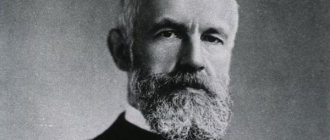- The idea of psychoanalysis.
- Free associations.
- Interpretation of dreams.
- Interpretation, resistance and transference.
- Stages of psychoanalysis.
This article does not pretend to be an exhaustive presentation of the topic and is intended for students studying psychology as part of retraining, on the basis of primary higher education, as well as for those who are only interested in the ideas of psychoanalysis.
Psychoanalysis, as a psychological practice of working with a client, is based on the ideas of its founding father, Sigmund Freud. Details about the origin of the method, as well as about the personality theory that formed the basis of psychoanalysis, are written in the relevant articles. Therefore, for a comprehensive understanding of this article, it is necessary to familiarize yourself with the previous ones.
What is the idea of psychoanalysis based on?
According to Freud, due to the contradiction between different personality structures, inevitable tension arises, which manifests itself in the form of neurotic states, neurotic behavior and/or mental disorders. The main contradiction, within the framework of such a personality structure, can be seen between natural desires (and the ID aspirations arising from them) and the Super Ego, which limits these aspirations. What happens then?
The natural aspirations of the individual come into conflict with social and personal attitudes, the source of which is perfectly understood by the EGO (I), in contrast to the former (ID), located in the subconscious. The natural urges of the ID in most cases (but not always) are considered by the EGO as unacceptable and threatening to the ideals of the Super Ego, and at the same time to social norms.
*These statements do not fully apply to societies where ID desires are considered socially acceptable and natural, this, in part, concerns the situation in so-called primitive communities.
The Ego's task is to reduce psychological tension (neurosis) without conflicting with personal ideals and morals. In cases where this cannot be done directly, through the satisfaction of these desires, then the frustrations from failure to fulfill problematic aspirations are partly leveled out by psychological defenses.
According to Freud, unsatisfied impulses are mostly suppressed and repressed into the area of the unconscious, where, nevertheless, they continue to exist in a form not recognized by the individual. Repressed aspirations manifest themselves in the form of psychological tension (neurosis), which naturally causes suffering to the individual.
As a result of his work with patients suffering from neuroses, Freud found out that some relief was brought by the fact of remembering and recognizing traumatic contents when, for one reason or another, they surfaced (remembered) from the subconscious. But for this therapeutic effect to occur, several conditions were required.
First, it was necessary to remember the circumstances of the development of the traumatic situation, and secondly, it was necessary to realize its original meaning.
One of Freud's postulates says that repressed material always strives to return to consciousness, however, it is blocked by psychological defenses. It was these blockages that were a problem because they interfered with memories. In addition, even if the contents of the subconscious were manifested in the patient’s consciousness, it was by no means in an explicit form, but more often in a veiled, coded form, in the form of certain symbols.
Methods of “extracting” memories of traumatic events from the unconscious and their subsequent interpretation are one of the main methods of psychoanalysis; this process takes quite a long time. In classical Freudian psychoanalysis, the following material is used, the source of which is the analysand (client) - free associations, transference, dreams and their interpretations, slips of the tongue, forgetting, analysis of resistance, as well as the method of interpretation.
Square
The main character trait of those who chose the square is hard work combined with organization, perseverance, patience and firmness, as well as punctuality, cleanliness and practicality. The choice of a square as the main figure may indicate a penchant for analytical thinking and rationality. Such a person strives to do all his affairs as well and efficiently as possible. And since he knows how to manage himself and organize others, he can occupy leadership positions.
The Square person is distinguished by conservatism, strict adherence to rules and regulations, and a lack of spontaneity and creativity. Strives to organize and systematize everything around him - space, things, any information with which he works. He likes it when information is presented in accordance with strict logic. The person who chose the square likes the speech to be replete with facts, figures and theses, preferably with links to the source from which it was taken. Prefers order, a planned life. He is picky about his acquaintances and does not like noisy parties. In conflicts, he often avoids direct confrontation. This is a good administrator and performer. Loses in efficiency of actions, contact with different people.
Women who choose a square are organized, punctual, picky, and attentive to details. They are patient, hardworking, persistent in achieving goals, firm in decisions and inclined to strictly follow rules and instructions. They don't like to stand out.
Square people usually speak quietly, preferring not to raise their voice unnecessarily. And they do not tolerate raised voices from others either. At the same time, their speech is distinguished by clarity, accuracy, logic and thoroughness. It tends to be somewhat monotonous and “mechanical.” They are characterized by the use of speech cliches.
Pedantry, scrupulousness and consistency are also evident in the choice of clothing. These people prefer a strict, classic style, restrained, soft colors. They are neat and lean. The reluctance to stand out is also manifested in gestures that are stingy and inexpressive.
Free association method
The essence of the method is that the patient tells the psychotherapist everything that currently comes to his mind, without caring at all about the content of his verbal flow, even if it is completely unacceptable for the patient himself. The initial concept (topic) can be anything - an object, numbers, image, word, etc., or the absence of any topic at all.
How is it that repressed material can nevertheless emerge into consciousness? When using the method of free association (when the elements of the output material are not rationally connected), the controlling function of consciousness is partially blocked, which means that psychological defenses do not work as effectively, which allows the repressed material to break out, in an explicit, and more often, encrypted form.
When conducting such a session, which usually lasts about an hour, the patient lies relaxed on the couch and does not see the psychoanalyst, this is important because the more relaxed the patient is, the less resistance to therapy on his part.
An incoherent monologue of a client, in the company of an analyst observing him, provides the most valuable material for subsequent work, because no matter how absurd this stream of words may seem, all the same, our thinking initially moves in the direction of concepts that are significant to us, which, sooner or later, make themselves known know. When researching, the following facts are important: the content of the client’s statements and their sequence. Of particular importance is the material that causes difficulties or internal resistance.
The subsequent identification of significant material and its interpretation is an important task for the psychoanalyst, since the reliability of this interpretation determines the success of the entire therapy as a whole.
What it is?
Translated from Latin, the word interpretatio means explanation, interpretation ).
Interpretation is a set of meanings attached to some elements of a theory (formulas, signs, symbols).
This definition of the term gives us an explanatory philosophical dictionary. In humanitarian knowledge, it is used in a meaning close to the word “understanding”
In a broader sense, interpretation is a way of being based on understanding and interpreting the meaning of something.
Synonyms for interpretation:
- interpretation;
- a comment;
- clarification of meaning;
- transcript.
Perceiving information from the environment, each person analyzes it in his own way. Of course, there are ideas and concepts that are common to everyone, but since all people have individual thinking, the same phenomena are interpreted differently.
Often this process occurs unconsciously (at the level of sensations, moral norms, rules of behavior laid down in childhood, and worldview). When a person uses his knowledge to decipher any data, the interpretation is directional in nature (for example, translations of texts from foreign or complex scientific languages into a native or easier to understand language).
You can interpret anything : information, events, dreams, laws, musical and literary works, films and even analyses.
Academician of the Russian Academy of Sciences Nikolai Moiseev wrote: “Different interpretations reflect only certain features of reality. No more! And they cannot always be consistent with each other, and sometimes they can contradict each other.”
Dream interpretation
The idea behind dream work is that dreams, even more than free association, are a source of subconscious material.
The more traumatic the information, the better it is protected and encrypted and, accordingly, the greater its value for the client.
Sometimes dreams tell us about our aspirations in a very obvious way, usually this happens in cases where what we want is not forbidden from the point of view of morals and ideals. In most cases, the content of the dream must be interpreted, and it expresses our secret aspirations and repressed, unacceptable material in symbolic form.
The task of interpreting dreams is very complex and requires a lot of experience and intuition from the psychologist, because some symbols may have special meaning for the patient, while others, despite their apparent significance, do not. For this reason, even generally accepted values often require careful verification through work with the client.
Brief summary
The importance of interpretation for each of us is difficult to overestimate. Every person should understand that their correct interpretation makes it possible to successfully communicate with others
Every person should understand that their correct interpretation makes it possible to successfully communicate with others.
Good luck to you! See you soon on the blog pages KtoNaNovenkogo.ru
* By clicking on the “Subscribe” button you agree to the privacy policy.
Collections by topic
- Questions and answers
- I use it to earn money
- Useful online services
- Description of useful programs
I use it to earn money
Interpretation method
As mentioned earlier, interpretation is the most important tool of a psychoanalyst when working with free associations and dreams. After all, it is one thing to receive material, and quite another to interpret it correctly. During interpretation, the received unconscious material is rationalized—awareness, together with the client, of the true causes of neurotic symptoms, as well as the true meaning of the client’s aspirations. It is the interpretation that can lead to a therapeutic result, naturally, only if it is interpreted correctly.
J. Piaget identified two strategies for explaining facts in psychology
1. Reductionism – reducing the complex to the simple: psychological to extra-psychological, social to biological, etc. It, in turn, is divided into: • Psychological reductionism - the reduction of several complex behaviors to the same simple principle of explanation. • Extra-psychological reductionism considers actions and reactions by reference to non-psychological laws. Sociological explanation looks at individual behavior through interactions with others. Physicalist explanations interpret behavior in terms of physical laws.
Organist explanations reduce the psychological to the physiological, while constructivist explanations emphasize the processes of construction. A behavioral theory model views behavior as a result of learning. The “genetic type” model interprets behavior as the result of genetically nested forms. “Abstract models” explain behavior through the presence of general laws.
2. Constructivism – building more complex explanations at the expense of simpler ones. Simple phenomena are considered in aggregate, constituting a complex subject of psychology.
The above methods of interpreting psychological phenomena can be used in combination, the ultimate goal of which is to state a fact. However, these discoveries cannot give an unambiguous answer to the question of whether this is an isolated (special) case or whether scientific results have revealed a certain general law.
There are a large number of ways to explain the psychological phenomena discussed in the online magazine psytheater.com. But they all go through three main stages:
The above scheme does not have a sufficient scientific basis in psychology, so today research is carried out according to a simpler scheme: 1. An empirical study is carried out. 2. A pattern is formulated. 3. Empirical information is found in the existing literature in order to relate the phenomenon to a specific group. 4. A general psychological interpretation is presented.
Transfer Analysis
In psychoanalysis, the analyst takes a position of some kind of closedness and detachment from the client. This leads to the fact that he is most often perceived by the client as an abstract symbolic figure. It is believed that it is for this reason that the so-called transference occurs, which means that the client unconsciously endows the psychologist with the traits of a personality that is significant to him, transferring his emotional attitude towards this personality to the figure of the analyst. It is as if the empty contents are being filled with new meanings. These could be, for example, traits of the father or mother (depending on the analyst's gender) or traits of another significant figure. Through subsequent analysis of the emerging phantom relationships between the client and the image of a significant person, aspects of the traumatic experiences received (most often in childhood) are revealed.
Main tasks
There are several ways to adapt new employees to a company. But they are united by one main goal, which is to help a person so that he can begin to fulfill his professional duties with maximum efficiency as quickly as possible. An effectively built adaptation system at an enterprise allows you to solve a number of main problems:
- introduce the employee into the work process in the shortest possible time}
- reduce the number of production errors made by a newcomer during the period of mastering professional responsibilities}
- encouraging new employees to achieve high performance indicators by motivating them to do so through monetary rewards or bonuses}
- reduce staff turnover as much as possible by reducing the number of employees who did not complete the probationary period or did not complete the internship}
- increase labor productivity of the entire enterprise as a whole.
Stages of psychoanalysis
To summarize, consider the sequence of work between an analyst and a client, which consists of several conventional stages.
The first stage is to search for a traumatic event in the client’s past. This is working with dreams, making reservations, using the method of free association, and conducting conversations.
The second stage is very conditional, it begins from the moment when the trauma is discovered and identified by the client himself as a traumatic experience. The client expresses himself through experiencing the newly discovered event, as well as rationalizing it, that is, understanding how exactly it led to the problems. This is a very painful stage; it is at this stage that what we called above transference or projection is formed. Most often this is expressed in a rather negative attitude towards the analyst on the part of the patient.
The third stage is expressed in a revaluation of traumatic events and a reduction in their significance, up to indifference and an indifferent attitude. At this stage, it is important to understand that the visible result is not just another defense or an imitation of the client’s calm attitude towards the problem.
Of course, the boundaries of all these stages are very arbitrary. This is due to the fact that problems do not come one at a time and a visible solution to one of them does not at all mean the end of the work, which can continue simultaneously at several stages.
In painting
Works of painting are always considered as a subject of interpretation
It is necessary to take into account the difference between two pictures of the world - the artist and the contemplator:
- the first draws a work based on the reality around him, his worldview and feelings;
- the second can only guess what the author wanted to say with his painting, whether his perception (what is it?) corresponds to the artist’s idea.
The works of abstract artists (W. Kandinsky, K. Malevich, P. Picasso) perhaps need this most of all.
When painting in this style, the master uses a visual language of shapes, lines, contours and colors to interpret the subject. This is very different from traditional painting styles, in which objects are interpreted closer to generally accepted ideas.










